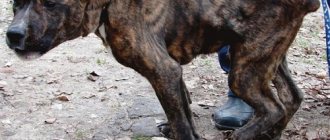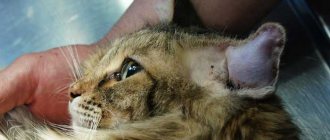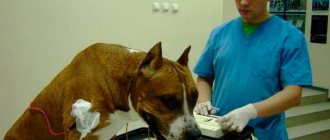04.09.2019
Care and health
no comments
4613
When your dog has a swollen toe, it's easy to underestimate the potential severity of the condition. Dog owners can sometimes chalk it up to an insect bite or something their dog may have stepped on. However, a swollen finger could be a sign of something much more serious. Cancerous tumors may initially appear as a swollen paw or finger. They must be diagnosed and treated as early as possible to achieve a positive outcome.
Types of tumors on the paws of dogs - malignant and benign
Tumors on the paws of dogs can be of two types: benign and malignant. The first ones grow slowly and can be of different sizes (from 1-2 mm to 10-15 cm in circumference). These tumors extremely rarely metastasize, form in one place, and have a capsule that inhibits the spread of cells.
A malignant or cancerous formation grows rapidly. Cells divide uncontrollably, due to the lack of a capsule, they first penetrate into nearby tissues and then spread throughout the body. However, it is impossible to predict in which part of the body a new cancerous tumor will arise.
IMPORTANT! Malignant tumors lead to the death of a pet in 80% of cases, but with timely initiation of treatment there is a chance to save the animal.
What is a mastectomy in dogs?
Surgical resection is the standard treatment for canine mammary tumors. It shows maximum effectiveness compared to other types of treatment. There are several types of mastectomy, but the choice of type does not affect prognosis or survival. It is rather a technical decision made by the surgeon in order to cure the animal as effectively as possible.
Did you know? Just like humans, cats and dogs can overheat in the sun and get skin cancer. Therefore, animals should not be walked on a hot summer afternoon.
The surgeon determines the type of operation and the extent of surgical removal after examining the patient and reviewing the medical history.
His decision is based on several characteristics:
- tumor location;
- its fixation relative to surrounding tissues and organs;
- possible extension to regional lymph nodes;
- the total number of tumors in a particular dog.
Why is a cancerous tumor on the paw dangerous?
Any malignant neoplasm poses a threat to the pet's life. The danger of a cancerous tumor on the paw is that very often the correct diagnosis is made already in the later stages, when treatment may not bring the desired result.
This is because many dogs do not show signs of illness, and the owner may not see them in a timely manner. At the stage when the animal becomes weakened and its temperature rises, the cancer cells are already growing significantly, and metastases appear in the internal organs.
At this stage, treatment may not bring results, and the pet dies after a few weeks or months.
Signs of melanoma
Tumors located on the skin, present as discrete and irregular growths, may or may not be pigmented and are located on the dog's face, trunk, feet and scrotum.
For melanomas that are in the mouth, the following symptoms :
- Bad breath.
- Salivation.
- Bleeding from the mouth.
- Facial deformation.
- Decreased appetite due to difficulty eating.
- Chewing on the side opposite to where the tumor is in the mouth.
Causes of development of tumors on the paws
Tumors on a pet’s paws can develop for various reasons:
- injuries and bruises;
- fractures;
- inflammatory process complicated by the penetration of bacteria;
- consequences of administering the drug intramuscularly;
- oncology, etc.
Often, bumps on the hind leg in the hip area form after vaccination or the administration of other drugs. This seal is small in size, does not cause discomfort to the pet and resolves on its own within 1-5 weeks. If the animal is worried or the tumor increases in size, you should consult a veterinarian.
The tumor can form due to a bite or other soft tissue injury. Bacteria penetrate into the wound and begin to actively multiply. As a result, a hot lump filled with blood and pus forms on your pet's paw. It is painful and soft to the touch.
Bumps on the paws and other parts of the body form against the background of pyoderma. This skin disease develops against a background of weakened immunity. On the paws, swelling often appears in the folds between the toes.
REFERENCE! Insect bites can also lead to the formation of dense bumps. Wasp and bee stings are especially dangerous, as they can cause anaphylactic shock in your pet.
Injury
A severe bruise can lead to a hematoma or abscess. In the first case, the tumor is soft, hot and quite painful. A hematoma is formed due to disruption of the functioning of blood vessels. Blood begins to accumulate under the skin, and the pet's body temperature may rise slightly.
If a limb is severely bruised, the integrity of the skin may be damaged and bacteria can enter the wound. As a result, a cavity is formed that fills with pus. Such a tumor is called an abscess. Infection of the hematoma can also lead to the formation of such an abscess.
Fracture
When a bone is broken, the affected limb may swell greatly. This occurs due to impaired blood flow to the limb. Violation of the integrity of muscle tissue and ligaments also leads to swelling. With such a tumor, the affected limb increases in size, the skin becomes very stretched. Swelling after a fracture causes severe pain to the animal.
Neoplasm
Common benign neoplasms on the paws include:
- Fibroma . Formed from connective and fibrous tissue. It grows very slowly, looks like a dense wart 1-5 cm in diameter. In most cases, fibroids grow above the skin rather than inside it. It is easily removed surgically and rarely causes discomfort to the pet.
- Histiocytoma. This neoplasm develops from epithelial cells. The tumor grows quite quickly (from 7 to 30 days), but then the immune system stops the growth of the lump. Histiocytoma is a dense nodule on the skin, the diameter does not exceed 4 cm.
- Lipoma. This neoplasm develops from fat cells located deep in the skin. A lipoma or wen can be of different sizes: from 0.5 to 7-10 cm. Tumors growing on the limbs rarely cause discomfort to the pet. Only very large lipomas create problems.
The following types of neoplasms are classified as cancerous (malignant):
- Hemangiosarcoma. This tumor is formed from cells in the walls of blood vessels. It looks like a dark plaque, the edges are poorly defined. The diameter of the cutaneous neoplasm does not exceed 2 cm. Such a tumor is accompanied by the formation of ulcers and bleeding.
- Hemangiopericytoma. A tumor is formed from pericytes (the so-called cells that are part of the walls of blood vessels). It is constantly growing, reaching 20-25 cm in size, and after removal it may reappear in its original place. The neoplasm has a hard structure with many nodules, the skin on the surface is devoid of hair, and can become covered with ulcers.
- Liposarcoma. These tumors are formed from subcutaneous lymphoblast cells. New growths are located under the skin, elastic or hard to the touch, and can reach 10 cm in diameter.
Not every cancerous tumor that has formed on a pet’s limb is capable of metastasizing. However, such a neoplasm can lead to the death of the animal if the owner does not begin treatment in time.
Symptoms and localization of tumors
Tumors in dogs appear on different parts of the body, including internal organs. Superficial neoplasms look like uncharacteristic lumps that are difficult to palpate and diagnose in the early stages.
Internal tumors lead to disruption not only of the affected area, but also cause a deterioration in the dog’s general condition: metabolic and gastrointestinal disorders, changes in blood composition, and neurological symptoms. Therefore, their appearance is indicated by various clinical symptoms (retching or vomiting, cough, shortness of breath, wheezing, diarrhea, constipation, anemia) and weight loss. Signs also vary significantly depending on their location.
Mammary gland
This is one of the most common locations, especially in unspayed females. Moreover, more than half of the detected formations are classified as malignant and give metastases throughout the body. They appear as one or more soft lumps located near the ridge of the mammary glands, which gradually enlarge and harden. They can be identified by palpation, but diagnosis can only be made using a biopsy.
Stomach
The development of a tumor on the abdomen is caused by several reasons:
- Skin cancer, which in the first stages looks like small nodules. But in a short period they merge into a single whole and grow to significant sizes.
- Damage to the abdominal cavity or gastrointestinal tract, when the lesion is located inside, but over time it grows and protrudes onto the surface of the body.
Brain
Neoplasms can appear in animals of any age and gender, but most often after reaching 5 years of age. Moreover, a high probability of their development is observed in Doberman Pinschers, Golden Retrievers, Bobtails, Pinschers and Scotch Terriers. The appearance of a tumor can be recognized by a decrease in motor activity, a desire to hide in dark places with the further manifestation of convulsions, disturbances in gait and coordination of movements, and the appearance of an unnatural tilt of the head.
Other localizations
Various types of swelling and neoplasms can also develop:
- On the ear, where otohematomas sometimes appear, which are associated with the destruction of blood vessels located inside the tissues and are not related to tumor processes. But in the ear it is also possible for pathological processes to develop in cartilaginous tissues and grow deep into the skull.
- On the neck, where mastocyomas sometimes develop - neoplasms from pathological mast cells that grow quickly and have a bad effect on the pet’s immunity. As mastocyma develops and grows, it will compress the blood vessels, upper respiratory tract and esophagus, which can lead to death.
- On the paws - soft neoplasms are one of the symptoms of skin cancer. Hard swellings can be a manifestation of osteosarcoma, a bone tissue pathology that gradually spreads throughout the limb and other bones. The dog begins to limp and does not want to get up on its paws, especially in the morning.
- Under the tail, where painless formations sometimes appear - lipomas, which grow slowly and do not bother the animal, but can develop into oncology.
Tumors by location
Depending on the location of the tumor, it can be located on the joints, on the front or hind legs, or between the toes.
On the front paw
The following types of tumors most often form on the front paw:
- Osteosarcoma or bone cancer. This is a malignant tumor that destroys bones from the inside.
- Swelling after a fracture. Dogs break their front limbs more often than their hind limbs.
- Wen (lipomas) and other malignant and benign neoplasms.
Most often, neoplasms appear on the inside of the forelimbs.
On the hind leg
A common complication in dogs is the appearance of lumps and swelling on the hind leg in the hip area. Such tumors appear after vaccination or intramuscular administration of drugs. They dissolve within 1-3 weeks and rarely cause discomfort to the animal.
Also, wen or lipomas often form on the outer surface of the hind legs. They do not bother the dog, but the owner must monitor the growth rate of such a lump, as a very large lipoma can interfere with the pet's movement.
Between the fingers
The following tumors may appear between the fingers:
- skin diseases (pyoderma, staphylococcus, etc.);
- injuries (splinter, cut, puncture, etc.);
- cancerous tumor (fibroma, etc.).
Also, small bumps and swelling between the fingers are formed due to allergies. They get wet, and the fur around them freezes into icicles. The pet actively licks such bumps, as they itch and bother the animal.
On the joint
A tumor in the joint is formed due to the following diseases:
- purulent arthritis (inflammation of the inner surface of the joint);
- synovitis (inflammation of the outer membrane of the joint);
- chronic osteoarthritis;
- bursitis (inflammation of the joint capsule).
A tumor on a joint causes severe pain to the animal. The dog is limping and lies down a lot. The affected joint is hot and painful to the touch, and is enlarged.
Symptoms
Infiltrative diseases of the stomach in dogs and cats (stomach tumors)
are usually asymptomatic in dogs and cats until the disease is quite advanced. The main initial symptom is usually anorexia (without vomiting). Vomiting in dogs and cats caused by neoplasia usually indicates an advanced stage of the disease or obstruction of the gastric excretory tract.
Adenocarcinomas are usually infiltrative in nature
and cause a decrease in the evacuation of contents from the stomach due to a decrease in its motility and/or obstruction of the excretory tract. Weight loss is usually associated with nutrient loss or cancer cachexia syndrome. Hematemesis is sometimes observed, but leiomyomas are more likely to cause severe acute bleeding in the upper gastrointestinal tract. Other bleeding stomach tumors are more likely to cause iron deficiency anemia, even if gastrointestinal bleeding is not obvious. Polyps rarely cause clinical symptoms unless pyloric obstruction occurs.
Drug treatment of tumors
Tumors such as swelling after a fracture or injury, hematomas, abscesses, some benign and malignant neoplasms are treated with medication.
For tumors accompanied by an inflammatory process (hematoma, abscess, etc.), the animal is prescribed rinsing the affected area with drainage and taking antibiotics.
Malignant neoplasms are treated only with chemotherapy. The drugs used destroy tumor cells, but they cause severe side effects (nausea, hair loss, impaired hematopoiesis, drop in leukocyte levels, etc.).
IMPORTANT! Chemotherapy should only be administered by a veterinarian and only after a complete examination of the pet.
Small benign neoplasms are not treated with drugs. If indicated, the surgeon removes them.
Surgical removal of the tumor
Most tumors are removed surgically. The operation is performed under general anesthesia. Before the procedure, the animal must be examined (blood tests are taken, an ECG is performed, etc.).
The animal is injected with a relaxant, which relaxes all the pet's muscles, and it loses the ability to move. After this, local or general anesthesia is administered, or the area around the affected area is numbed. After this, the tumor and part of the healthy tissue around it are removed and stitches are applied.
IMPORTANT! Part of the tumor must be sent for histology. Using this study, you can find out whether this tumor is malignant or benign.
Mammary tumors in dogs treatment
The main method is surgical. Before the intervention, the age of the animal, concomitant diseases, and the clinical stage of the pathology are clarified. Based on the collected medical history, a surgical plan is developed taking into account oncological radicalism, which involves removing the tumor with a certain amount of surrounding tissue not affected by the tumor.
Performing an operation requires data on the extent of the tumor and the routes of metastasis. Long-term positive results are achieved through adherence to the principles of ablastics, including preventing the dissemination (scattering) of tumor cells by the operating doctor.
Depending on the data from diagnostic studies, a course of chemotherapy may be prescribed.
Possible postoperative complications
Surgeries to remove small growths rarely lead to a deterioration in the pet's condition.
Possible postoperative complications can be caused by general anesthesia:
- labored breathing;
- disruption of the heart;
- aspiration (entry into the lungs or respiratory tract of stomach contents during vomiting);
- cerebral edema due to hypoxia.
It is quite possible to avoid complications. To do this, before sending the animal for surgery, it is necessary to examine its heart and do general and biochemical blood tests.










